Chymotrypsin C is a co-activator of human pancreatic procarboxypeptidases A1 and A2
- PMID: 21098023
- PMCID: PMC3023477
- DOI: 10.1074/jbc.M110.187369
Chymotrypsin C is a co-activator of human pancreatic procarboxypeptidases A1 and A2
Abstract
Human digestive carboxypeptidases CPA1, CPA2, and CPB1 are secreted by the pancreas as inactive proenzymes containing a 94-96-amino acid-long propeptide. Activation of procarboxypeptidases is initiated by proteolytic cleavage at the C-terminal end of the propeptide by trypsin. Here, we demonstrate that subsequent cleavage of the propeptide by chymotrypsin C (CTRC) induces a nearly 10-fold increase in the activity of trypsin-activated CPA1 and CPA2, whereas CPB1 activity is unaffected. Other human pancreatic proteases such as chymotrypsin B1, chymotrypsin B2, chymotrypsin-like enzyme-1, elastase 2A, elastase 3A, or elastase 3B are inactive or markedly less effective at promoting procarboxypeptidase activation. On the basis of these observations, we propose that CTRC is a physiological co-activator of proCPA1 and proCPA2. Furthermore, the results confirm and extend the notion that CTRC is a key regulator of digestive zymogen activation.
Figures
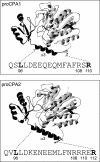
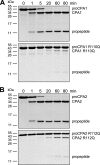
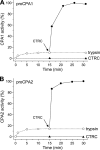
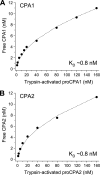
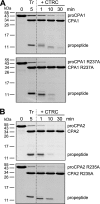


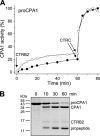
Similar articles
-
Complex Formation of Human Proelastases with Procarboxypeptidases A1 and A2.J Biol Chem. 2016 Aug 19;291(34):17706-16. doi: 10.1074/jbc.M116.743237. Epub 2016 Jun 29. J Biol Chem. 2016. PMID: 27358403 Free PMC article.
-
Mesotrypsin Signature Mutation in a Chymotrypsin C (CTRC) Variant Associated with Chronic Pancreatitis.J Biol Chem. 2015 Jul 10;290(28):17282-92. doi: 10.1074/jbc.M114.618439. Epub 2015 May 26. J Biol Chem. 2015. PMID: 26013824 Free PMC article.
-
Chymotrypsin C (caldecrin) promotes degradation of human cationic trypsin: identity with Rinderknecht's enzyme Y.Proc Natl Acad Sci U S A. 2007 Jul 3;104(27):11227-32. doi: 10.1073/pnas.0703714104. Epub 2007 Jun 25. Proc Natl Acad Sci U S A. 2007. PMID: 17592142 Free PMC article.
-
Pancreatic procarboxypeptidases: oligomeric structures and activation processes revisited.Biol Chem. 1997 Mar-Apr;378(3-4):161-5. Biol Chem. 1997. PMID: 9165066 Review.
-
The role of pancreatic enzymes in digestion.Am J Clin Nutr. 1973 Mar;26(3):311-25. doi: 10.1093/ajcn/26.3.311. Am J Clin Nutr. 1973. PMID: 4347665 Review. No abstract available.
Cited by
-
Variants in CPA1 are strongly associated with early onset chronic pancreatitis.Nat Genet. 2013 Oct;45(10):1216-20. doi: 10.1038/ng.2730. Epub 2013 Aug 18. Nat Genet. 2013. PMID: 23955596 Free PMC article.
-
Genetic and phenotypic heterogeneity in tropical calcific pancreatitis.World J Gastroenterol. 2014 Dec 14;20(46):17314-23. doi: 10.3748/wjg.v20.i46.17314. World J Gastroenterol. 2014. PMID: 25516642 Free PMC article. Review.
-
Carboxypeptidase O is a lipid droplet-associated enzyme able to cleave both acidic and polar C-terminal amino acids.PLoS One. 2018 Nov 2;13(11):e0206824. doi: 10.1371/journal.pone.0206824. eCollection 2018. PLoS One. 2018. PMID: 30388170 Free PMC article.
-
Genetic Variability in the CPA1 Gene and Its Impact on Acute Pancreatitis Risk: New Insights from a Large-Scale Study.Int J Mol Sci. 2024 Oct 21;25(20):11301. doi: 10.3390/ijms252011301. Int J Mol Sci. 2024. PMID: 39457082 Free PMC article.
-
Pathogenic cellular role of the p.L104P human cationic trypsinogen variant in chronic pancreatitis.Am J Physiol Gastrointest Liver Physiol. 2016 Apr 1;310(7):G477-86. doi: 10.1152/ajpgi.00444.2015. Epub 2016 Jan 28. Am J Physiol Gastrointest Liver Physiol. 2016. PMID: 26822915 Free PMC article.
References
-
- Folk J. E., Schirmer E. W. (1965) J. Biol. Chem. 240, 181–192 - PubMed
-
- Folk J. E., Cole P. W. (1965) J. Biol. Chem. 240, 193–197 - PubMed
-
- Keil-Dlouha V., Puigserver A., Marie A., Keil B. (1972) Biochim. Biophys. Acta 276, 531–535 - PubMed
-
- Iio-Akama K., Sasamoto H., Miyazawa K., Miura S., Tobita T. (1985) Biochim. Biophys. Acta 831, 249–256 - PubMed
Publication types
MeSH terms
Substances
Grants and funding
LinkOut - more resources
Full Text Sources
Molecular Biology Databases

